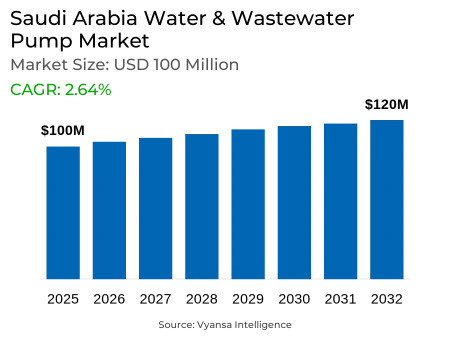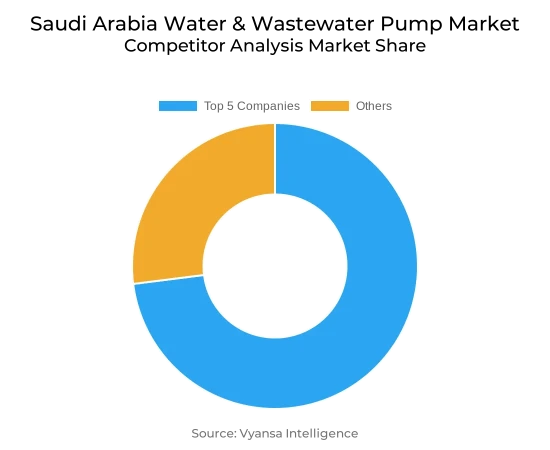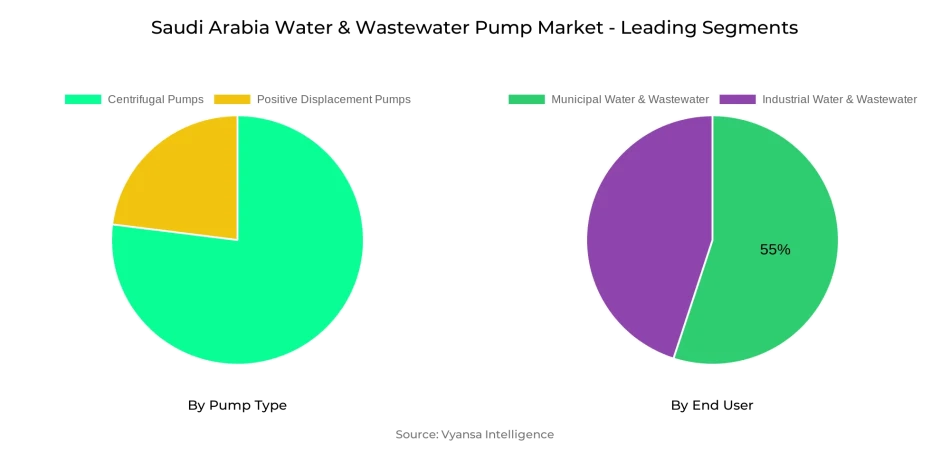
Saudi Arabia Water & Wastewater Pump Market Report: Trends, Growth and Forecast (2026-2032)
By Pump Type (Centrifugal Pumps (End Suction, Split Case, Vertical (Turbine, Axial Pump, Mixed Flow Pump), Submersible Pump), Positive Displacement Pumps (Progressing Cavity, Diaphragm, Gear Pump, Others)), By Application (Water, Wastewater), By End User (Industrial Water & Wastewater, Municipal Water & Wastewater)
- Energy & Power
- Oct 2025
- VI0487
- 125
-




Saudi Arabia Water & Wastewater Pump Market Statistics and Insights, 2026
- Market Size Statistics
- Water & Wastewater Pump in Saudi Arabia is estimated at $ 100 Million.
- The market size is expected to grow to $ 120 Million by 2032.
- Market to register a CAGR of around 2.64% during 2026-32.
- Pump Type Segment
- Centrifugal Pumps continues to dominate the market.
- Competition
- More than 10 companies are actively engaged in producing Water & Wastewater Pump in Saudi Arabia.
- Top 5 companies acquired the maximum share of the market.
- ITT, IDEX, Dover, Flowserve, Sulzer AG etc., are few of the top companies.
- End User
- Municipal Water & Wastewater grabbed 55% of the market.
Saudi Arabia Water & Wastewater Pump Market Outlook
Saudi Arabia's massive infrastructure development and sustainability initiatives are propelling consistent growth in the water and wastewater pump sector. The nation has invested $80 billion on water projects, representing 45% of its total $180 billion sustainability investment. With over 40 public-private partnership projects in progress, including desalination plants and wastewater treatment plants, demand for sophisticated pumping systems keeps growing. The market in 2025 is placed at USD 100 million and expected to reach USD 120 million in 2032, representing steady growth between 2026–32.
Urban water and wastewater use lead the market, covering 55% of the share, buoyed by enormous government investment in urban drainage, treatment, and water supply infrastructure. With a population of more than 37 million, this segment necessitates high-capacity and dependable pumping solutions for round-the-clock operations. The industrial market is the fastest-growing end user, though, as Saudi Arabia strives to diversify its economy in line with Vision 2030, generating increasing demand from processing plants, petrochemicals, and manufacturing plants.
On the basis of pump type, centrifugal pumps are the market leaders, it is because of their efficiency and applicability in large-scale distribution of water, desalination, and municipal supply. Positive displacement pumps, although smaller in market share, are seeing quicker adoption for niche applications needing accurate flow and high-pressure operations. This paired ranking is indicative of both the dominance of incumbent technologies and the increasing importance of specialty solutions.
Energy efficiency is also a key area of focus, as desalination is responsible for approximately 75% of the Kingdom's water supply and is a big energy consumer. Increased use of renewable power in water initiatives, such as solar-powered desalination plants, is opening up opportunities for pumps to work with variable energy inputs effectively. Concurrently, advanced water technologies like IoT-based systems, leak sensors, and AI-based monitoring are being installed to minimize water losses and maximize efficiency, contributing to the market's outlook.

Saudi Arabia Water & Wastewater Pump Market Growth Driver
Expanding Infrastructure Development Fuels Demand
Saudi Arabia's enormous infrastructure development programs are generating record demand for water and wastewater pumping systems throughout the Kingdom. The nation has earmarked $80 billion in particular for water projects over the next few years, 45% of its overall $180 billion sustainability investment pledge. The National Water Company is set to award the $220 million Al Suwayriqiyah and Al Aqiliyah Water Networks project, which comprises main pumping stations and water distribution networks in the Mahd governorate.
With the government announcing more than 40 water public-private partnership projects, ranging from desalination plants to wastewater treatment plants, the Kingdom has seen an infrastructure boom that will see huge pumping requirements. The Saudi Water Partnership Company has invested $6.28 billion in projects already ongoing relating to water distribution, treatment plants, and wastewater collection networks, which will open up huge market opportunities for pump manufacturers and suppliers.
Saudi Arabia Water & Wastewater Pump Market Challenge
Energy Costs and Operating Efficiency Present Challenges
High energy requirements are still a major problem for water and wastewater pumping facilities in Saudi Arabia. Desalination operations use over six times more energy than the industrial sector and now generate an increasingly dominant share of the Kingdom's water supplies, putting enormous pressure on operational budgets. The nation utilized 2.9 million barrels per day of petroleum products and crude in 2020, most of which was utilized for desalination and power generation, underlining the energy-intensive nature of water operations.
Operating expenses are also higher due to the Kingdom's overdependence on desalination, which provides around 75% of the water supply. Its current irrigation efficiency is only at about 50% as against global best practice at 85%, with much potential for upgrading but also with considerable investment needed in system replacements. Such operational issues demand pump systems that have maximum efficiency but least energy usage to facilitate long-term sustainable operations.
Saudi Arabia Water & Wastewater Pump Market Trend
Digital Innovation Transforms Water Management Systems
Advanced digital technologies are transforming water management practices throughout Saudi Arabia, opening up new chances for smart pumping solutions. The Kingdom launched the Wabel Incubator in February 2025, a joint initiative of the National Water Company and Saudi Water Innovation Center to create innovation and promote advanced technologies within the water sector.
IoT-based systems, such as smart meters and leak detectors, are saving water losses of up to 30% while enhancing the efficiency of operations. The convergence of artificial intelligence and blockchain technology is establishing transparent and efficient networks for water management that can identify leaks in an instant, anticipate water demand, and optimize distribution networks. These technological advancements are making Saudi Arabia a leader in smart utility management, where over 80 initiatives were launched that translate into over SAR 705 billion worth of investments in digital water solutions.
Saudi Arabia Water & Wastewater Pump Market Opportunity
Renewable Energy Integration to Drive Market Growth
Saudi Arabia's pledge to get 50% of its electricity from renewable sources by 2030 is opening up real opportunities for energy-efficient pumping systems in water infrastructure. The Kingdom has managed to build 44.2 GW of renewable capacity, sufficient to power 7 million homes, allowing businesses to shift to smart water management solutions that lower costs of operation. A number of desalination plants are already driven by renewable power, such as the 90,000 m³/day Al-Khafji plant and the 600,000 m³/day Jazlah plant.
The integration of solar-powered desalination is expanding rapidly, with projects like Engie's 450,000 m³/day Yanbu 4 and 570,000 m³/day Jubail 3B plants currently in development. NEOM's planned reverse osmosis desalination facility, set for completion in 2025, will be entirely powered by renewable energy and produce 500,000 cubic meters of water daily. These developments require specialized pumping systems designed to operate efficiently with variable renewable energy sources while maintaining consistent water production levels.
Saudi Arabia Water & Wastewater Pump Market Segmentation Analysis

By Pump Type
- Centrifugal Pumps
- Positive Displacement Pumps
The largest market segment in the Pump Type category is Centrifugal Pumps, which remains the market leader in the Saudi Arabia water and wastewater pump market. Centrifugal pumps maintain a dominant position with a good revenue share, and hence they are the biggest segment in the category of pump types. These pumps are most preferred due to their efficiency and versatility to handle various kinds of fluids in various applications related to water throughout the Kingdom.
Positive displacement pumps have a smaller but significant market share when compared to centrifugal pumps within the Saudi Arabian context. Nevertheless, positive displacement pumps are the most rapidly growing segment, reflecting growing acceptance for specialized applications involving efficient flow control and high-pressure performance. The supremacy of centrifugal pumps indicates the compatibility of these pumps with the Kingdom's widespread water distribution networks, desalination plants, and large municipal water systems that need high-volume fluid movement capacity.
By End User
- Industrial Water & Wastewater
- Municipal Water & Wastewater
The highest market share within the End User category belongs to Municipal Water & Wastewater, which took 55% of the market share. This leadership is an indication of Saudi Arabia's huge investment in urban water infrastructure and the urgent necessity to serve the Kingdom's large population of more than 37 million people. Municipal end-use applications include water distribution networks, wastewater treatment plants, and urban drainage systems that need dependable pumping solutions for around-the-clock operation.
Industrial Water & Wastewater is the highest-growing end user segment at a CAGR of 3.69%, fueled by economic diversification efforts of the Kingdom under Vision 2030. The growth of the industrial sector involves petrochemical plants, manufacturing units, and processing operations requiring sophisticated pumping equipment for water treatment and waste management. This trend is a reflection of growing industrial activity and the need for high-end water management solutions in Saudi Arabia's growing industrial base.
Top Companies in Saudi Arabia Water & Wastewater Pump Market
The top companies operating in the market include ITT, IDEX, Dover, Flowserve, Sulzer AG, KSB, Xylem, Grundfos, Ebara, SPX Flow, etc., are the top players operating in the Saudi Arabia Water & Wastewater Pump Market.
Frequently Asked Questions
Related Report
1. Market Segmentation
1.1. Research Scope
1.2. Research Methodology
1.3. Definitions and Assumptions
2. Executive Summary
3. Saudi Arabia Water & Wastewater Pump Market Policies, Regulations, and Standards
4. Saudi Arabia Water & Wastewater Pump Market Dynamics
4.1. Growth Factors
4.2. Challenges
4.3. Trends
4.4. Opportunities
5. Saudi Arabia Water & Wastewater Pump Market Statistics, 2022-2032F
5.1. Market Size & Growth Outlook
5.1.1.By Revenues in US$ Million
5.2. Market Segmentation & Growth Outlook
5.2.1.By Pump Type
5.2.1.1. Centrifugal Pumps- Market Insights and Forecast 2022-2032, USD Million
5.2.1.1.1. End Suction- Market Insights and Forecast 2022-2032, USD Million
5.2.1.1.2. Split Case- Market Insights and Forecast 2022-2032, USD Million
5.2.1.1.3. Vertical- Market Insights and Forecast 2022-2032, USD Million
5.2.1.1.3.1. Turbine- Market Insights and Forecast 2022-2032, USD Million
5.2.1.1.3.2. Axial Pump- Market Insights and Forecast 2022-2032, USD Million
5.2.1.1.3.3. Mixed Flow Pump- Market Insights and Forecast 2022-2032, USD Million
5.2.1.1.4. Submersible Pump- Market Insights and Forecast 2022-2032, USD Million
5.2.1.2. Positive Displacement Pumps- Market Insights and Forecast 2022-2032, USD Million
5.2.1.2.1. Progressing Cavity- Market Insights and Forecast 2022-2032, USD Million
5.2.1.2.2. Diaphragm- Market Insights and Forecast 2022-2032, USD Million
5.2.1.2.3. Gear Pump- Market Insights and Forecast 2022-2032, USD Million
5.2.1.2.4. Others- Market Insights and Forecast 2022-2032, USD Million
5.2.2.By Application
5.2.2.1. Water- Market Insights and Forecast 2022-2032, USD Million
5.2.2.2. Wastewater- Market Insights and Forecast 2022-2032, USD Million
5.2.3.By End User
5.2.3.1. Industrial Water & Wastewater- Market Insights and Forecast 2022-2032, USD Million
5.2.3.2. Municipal Water & Wastewater- Market Insights and Forecast 2022-2032, USD Million
5.2.4.By Competitors
5.2.4.1. Competition Characteristics
5.2.4.2. Market Share & Analysis
6. Saudi Arabia Centrifugal Water & Wastewater Pump Market Statistics, 2020-2030F
6.1. Market Size & Growth Outlook
6.1.1.By Revenues in US$ Million
6.2. Market Segmentation & Growth Outlook
6.2.1.By Pump Type- Market Insights and Forecast 2022-2032, USD Million
6.2.2.By Application- Market Insights and Forecast 2022-2032, USD Million
6.2.3.By End User- Market Insights and Forecast 2022-2032, USD Million
7. Saudi Arabia Positive Displacement Water & Wastewater Pump Market Statistics, 2020-2030F
7.1. Market Size & Growth Outlook
7.1.1.By Revenues in US$ Million
7.2. Market Segmentation & Growth Outlook
7.2.1.By Pump Type- Market Insights and Forecast 2022-2032, USD Million
7.2.2.By Application- Market Insights and Forecast 2022-2032, USD Million
7.2.3.By End User- Market Insights and Forecast 2022-2032, USD Million
8. Competitive Outlook
8.1. Company Profiles
8.1.1.Flowserve Corporation
8.1.1.1. Business Description
8.1.1.2. Product Portfolio
8.1.1.3. Collaborations & Alliances
8.1.1.4. Recent Developments
8.1.1.5. Financial Details
8.1.1.6. Others
8.1.2.Ebara Corporation
8.1.2.1. Business Description
8.1.2.2. Product Portfolio
8.1.2.3. Collaborations & Alliances
8.1.2.4. Recent Developments
8.1.2.5. Financial Details
8.1.2.6. Others
8.1.3.WILO SE
8.1.3.1. Business Description
8.1.3.2. Product Portfolio
8.1.3.3. Collaborations & Alliances
8.1.3.4. Recent Developments
8.1.3.5. Financial Details
8.1.3.6. Others
8.1.4.Sulzer Limited
8.1.4.1. Business Description
8.1.4.2. Product Portfolio
8.1.4.3. Collaborations & Alliances
8.1.4.4. Recent Developments
8.1.4.5. Financial Details
8.1.4.6. Others
8.1.5.Grundfos Holding A/S
8.1.5.1. Business Description
8.1.5.2. Product Portfolio
8.1.5.3. Collaborations & Alliances
8.1.5.4. Recent Developments
8.1.5.5. Financial Details
8.1.5.6. Others
8.1.6.Xylem Inc.
8.1.6.1. Business Description
8.1.6.2. Product Portfolio
8.1.6.3. Collaborations & Alliances
8.1.6.4. Recent Developments
8.1.6.5. Financial Details
8.1.6.6. Others
8.1.7.KSB SE & Co. KGaA
8.1.7.1. Business Description
8.1.7.2. Product Portfolio
8.1.7.3. Collaborations & Alliances
8.1.7.4. Recent Developments
8.1.7.5. Financial Details
8.1.7.6. Others
8.1.8.Kirloskar Brothers Limited (KBL)
8.1.8.1. Business Description
8.1.8.2. Product Portfolio
8.1.8.3. Collaborations & Alliances
8.1.8.4. Recent Developments
8.1.8.5. Financial Details
8.1.8.6. Others
8.1.9.Franklin Electric
8.1.9.1. Business Description
8.1.9.2. Product Portfolio
8.1.9.3. Collaborations & Alliances
8.1.9.4. Recent Developments
8.1.9.5. Financial Details
8.1.9.6. Others
8.1.10. Pentair PLC
8.1.10.1. Business Description
8.1.10.2. Product Portfolio
8.1.10.3. Collaborations & Alliances
8.1.10.4. Recent Developments
8.1.10.5. Financial Details
8.1.10.6. Others
9. Disclaimer
| Segment | Sub-Segment |
|---|---|
| By Pump Type |
|
| By Application |
|
| By End User |
|
Research Methodology
This study followed a structured approach comprising four key phases to assess the size and scope of the electro-oxidation market. The process began with thorough secondary research to collect data on the target market, related markets, and broader industry context. These findings, along with preliminary assumptions and estimates, were then validated through extensive primary research involving industry experts from across the value chain. To calculate the overall market size, both top-down and bottom-up methodologies were employed. Finally, market segmentation and data triangulation techniques were applied to refine and validate segment-level estimations.
Secondary Research
The secondary research phase involved gathering data from a wide range of credible and published sources. This step helped in identifying industry trends, defining market segmentation, and understanding the market landscape and value chain.
Sources consulted during this phase included:
- Company annual reports, investor presentations, and press releases
- Industry white papers and certified publications
- Trade directories and market-recognized databases
- Articles from authoritative authors and reputable journals
- Gold and silver standard websites
Secondary research was critical in mapping out the industry's value chain and monetary flow, identifying key market segments, understanding regional variations, and tracking significant industry developments.
Other key sources:
- Financial disclosures
- Industry associations and trade bodies
- News outlets and business magazines
- Academic journals and research studies
- Paid industry databases
Primary Research
To validate secondary data and gain deeper market insights, primary research was conducted with key stakeholders across both the supply and demand sides of the market.
On the demand side, participants included decision-makers and influencers from end-user industries—such as CIOs, CTOs, and CSOs—who provided first-hand perspectives on market needs, product usage, and future expectations.
On the supply side, interviews were conducted with manufacturers, industry associations, and institutional participants to gather insights into current offerings, product pipelines, and market challenges.
Primary interviews provided critical inputs such as:
- Market size and revenue data
- Product and service breakdowns
- Market forecasts
- Regional and application-specific trends
Stakeholders consulted included:
- Leading OEM and solution providers
- Channel and distribution partners
- End users across various applications
- Independent consultants and industry specialists
Market Size Estimation and Data Triangulation
- Identifying Key Market Participants (Secondary Research)
- Goal: To identify the major players or companies in the target market. This typically involves using publicly available data sources such as industry reports, market research publications, and financial statements of companies.
- Tools: Reports from firms like Gartner, Forrester, Euromonitor, Statista, IBISWorld, and others. Public financial statements, news articles, and press releases from top market players.
- Extracting Earnings of Key Market Participants
- Goal: To estimate the earnings generated from the product or service being analyzed. This step helps in understanding the revenue potential of each market player in a specific geography.
- Methods: Earnings data can be gathered from:
- Publicly available financial reports (for listed companies).
- Interviews and primary data sources from professionals, such as Directors, VPs, SVPs, etc. This is especially useful for understanding more nuanced, internal data that isn't publicly disclosed.
- Annual reports and investor presentations of key players.
- Data Collation and Development of a Relevant Data Model
- Goal: To collate inputs from both primary and secondary sources into a structured, data-driven model for market estimation. This model will incorporate key market KPIs and any independent variables relevant to the market.
- Key KPIs: These could include:
- Market size, growth rate, and demand drivers.
- Industry-specific metrics like market share, average revenue per customer (ARPC), or average deal size.
- External variables, such as economic growth rates, inflation rates, or commodity prices, that could affect the market.
- Data Modeling: Based on this data, the market forecasts are developed for the next 5 years. A combination of trend analysis, scenario modeling, and statistical regression might be used to generate projections.
- Scenario Analysis
- Goal: To test different assumptions and validate how sensitive the market is to changes in key variables (e.g., market demand, regulatory changes, technological disruptions).
- Types of Scenarios:
- Base Case: Based on current assumptions and historical data.
- Best-Case Scenario: Assuming favorable market conditions, regulatory environments, and technological advancements.
- Worst-Case Scenario: Accounting for adverse factors, such as economic downturns, stricter regulations, or unexpected disruptions.
Partnering With Industry Leaders to Drive Growth
Our mission is to deliver intelligence that matters. By combining data, analysis, and industry expertise, we enable organizations to make smarter, faster, and more impactful decisions. Whether it’s a Fortune 500 company or a high-growth startup, businesses trust us to provide clarity in an ever-evolving marketplace.






